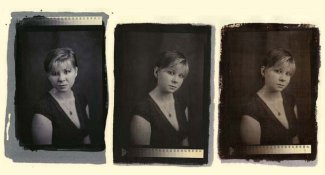Well, great results from my initial experiments. I used two different salt formulas and tried brush sizing and sizing using a puddle pusher and got equally good results. The difference in today's prints compared to my past efforts has to do with a change in paper and in the silver nitrate sensitizing solution.
I got the following recipe from Michael Mazzeo (
http://www.michaelmazzeo.com/) who I took a wetplate collodion workshop from 2 months ago. (Great workshop BTW.)
Salting stock solution is 2 gm ammonium chloride in 98 ml distilled water.
Paper is Crane's Cover stock.
Sensitizer stock is 20 gm silver nitrate in 80 ml distilled water. This solution is brought to pH2 by the addition of citric acid crystals. (It took about 1/2 tsp of citric acid to reach this pH.)
The paper is salted using a hake brush and dried. Then, under a red safelight I used a different hake brush to apply the silver nitrate solution and the sensitized paper was then dried in the dark.
Following exposure I bathed the print in a 1 1/2% solution of sodium chloride for a couple minutes then followed that by a 5 minute wash until no cloudiness was observed coming from the print. Clerc's Gold Toner was used until a lilac color was achieved. The print was then rinsed in tap water and fixed in a solution of plain hypo (15 gm sodium thiosulfate in 1 liter water) for 5 minutes each in two successive baths. After a 1 minute rinse in tap water, I immersed the print in a solution of Kodak Hypo Clearing Agent for 5 minutes followed by a 30 minute wash. It's not dry yet but it looks like the nicest salt print I've ever made.
I also used a different salt solution on one print and that looks like it worked equally well (although I overexposed that print). That salting solution was:
6gm sodium chloride
8 gm ammonium chloride
13 gm sodium citrate
3 gm 250 bloom ossein (photographic gelatin)
600ml water
The ossein was added to the water and allowed to swell for 15 minutes. The solution was then heated slowly until it reached about 100F and the gelatin dissolved. The other ingredients were then added in the order given.
I'm very pleased with what I did today and will post a scan of the properly exposed print as soon as I can get to it.
I think the stronger silver nitrate solution (20% instead of the usually recommended 12%) and dropping the sensitizer pH to pH2 with the citric acid really made a big difference. The coating is very even and there is good max density with a single coat of sensitizer regardless of whether it was done with a brush or glass coating rod. Salted paper has always given me headaches with inconsistent and poor results in the past, but this combo looks like a winner.
Joe














